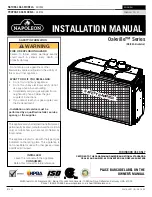
IHP.us.com
900861-00NC
6
WARNING: Proper clearances from combustible, construction
materials must be maintained from all sides, top and bottom of
this appliance. See specifications listed on
Pages 8-10
for a sin-
gle-sided fireplace and
Pages 11-14
for a see-through fireplace.
IMPORTANT
Installation of Natural or Liquid Propane Gas should be done by a
qualified installer, service agency or gas supplier.
The appliance and its appliance main gas valve must be disconnected
from the gas supply piping system during any pressure testing
of that system at test pressures in excess of 1/2 psi (3.5 kPa).
The appliance must be isolated from the gas supply piping system
by closing its equipment shutoff valve during any pressure testing
of the gas supply piping system at test pressures equal to or less
than 1/2 psi (3.5 kPa).
PAY CLOSE ATTENTION TO THE FOLLOWING PAG-
ES. THIS FIREPLACE IS SHIPPED AS A
SINGLE-SIDED FIREPLACE, HOWEVER YOU HAVE
THE OPTION TO CONVERT IT INTO A
SEE-THROUGH FIREPLACE. READ THE HEADERS
CAREFULLY TO ENSURE YOU ARE
FOLLOWING THE CORRECT INSTALLATION.
UNLESS SPECIFIED, ALL OTHER PAGES ARE COM-
MON FOR THESE FIREPLACES. REVIEW THE
INSTALLATION PRECAUTIONS BEFORE INSTALLING
ANY OF THESE MODELS. IF YOU HAVE ANY QUES-
TIONS PLEASE CONTACT YOUR DEALER OR GO TO
IHP.US.COM FOR REFERRAL INFORMATION.
The fireplace must be installed on a flat, level, stable, non-combus-
tible surface. If one layer of 1/2” cement board is installed under-
neath the entire fireplace, it may sit on a flat, level, stable, combus-
tible surface. Install fireplace according to the clearances specified
in this manual.
NOTE: Do not place fireplace directly on grass, dirt,
or rocks as this may prevent proper ventilation. Ensure proper wa-
ter drainage is also incorporated under the fireplace enclosure.
HARD PIPING TO FIREPLACE WITHOUT GAS PROXIMITY
NOTE: We recommend using 3/4” black iron pipe; however please
refer to the National Fuel Gas Code, ANSI Z223.1/ NFPA 54 (USA)
- latest edition or CAN/CGA-B149.1 Natural Gas And Propane In-
stallation Code (Canada) - latest edition for proper pipe sizing when
exceeding 20-feet in length for fireplaces rated above 100,000 BTU.
1. Turn OFF gas supply system.
NOTE: All gas connections (except
for brass to brass) require the following: Clean pipe threads us-
ing either a wire brush or steel wool. Apply pipe sealant to the
fittings before making any connection. BE CAREFUL! Ensure all
gas connections are snug, but do not over tighten!
2. Extend the gas supply using minimum of 3/4” black iron pipe or
an approved flexible gas line from existing house supply. This
can be accomplished by teeing off or tapping into a gas line
connection. Install necessary pipe for the distance required and
then install a manual shutoff valve at the exterior house wall. If
pipe is to pass through a foundation or house wall, make sure
to re-seal the area around the pipe with weather sealant.
3. The primary gas shutoff (supplied) will require a 1/2” male
flared fitting to enable connection of the stainless steel flex gas
line supplied with the fireplace
(See Figure 1, Page 5).
The bottom support fin seen in several figure drawings on
Pages 9
to 14
has pre-punched holes on inside edge to secure the fireplace
into position before attaching cement board.
HIGH ELEVATION INSTALLATION
This appliance is listed for elevations from 0 to 4500 feet (0-1372
meters) in Canada and the U.S. If elevation exceeds 4500 feet it may
be necessary to decrease the input rating by changing the existing
burner orifice to a smaller size. Input should be reduced 4% for
each 1000 feet beyond the 4500 feet above sea level. Check with
your local gas utility for assistance in determining the proper orifice
in your location. In some cases the heating value may already be
reduced and downsizing the orifice may not be necessary.
Deration - At higher elevations, the amount of BTU fuel value delivered
must be reduced by either:
• Using gas that has been derated by the gas company.
• By changing the burner orifice to a smaller size as regulated by the
local authorities having jurisdiction and by the (USA) National Fuel
Gas Code NFPA 54/ANSI Z223.1—latest edition or, in Canada, the
CAN/CSA-B149.1 codes—latest edition.
Install the appliance according to the regulations of the local authori-
ties having jurisdiction and, in the USA, the National Fuel Gas Code
NFPA 54 / ANSI Z223.1—latest edition or, in Canada, the CAN/CGA-
B149.1—latest edition.
INSTALLATION PRECAUTIONS
Continued







































